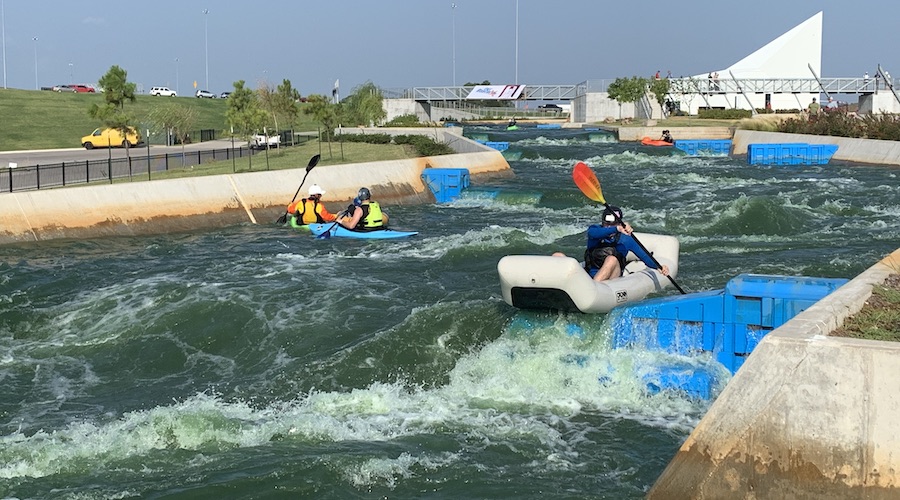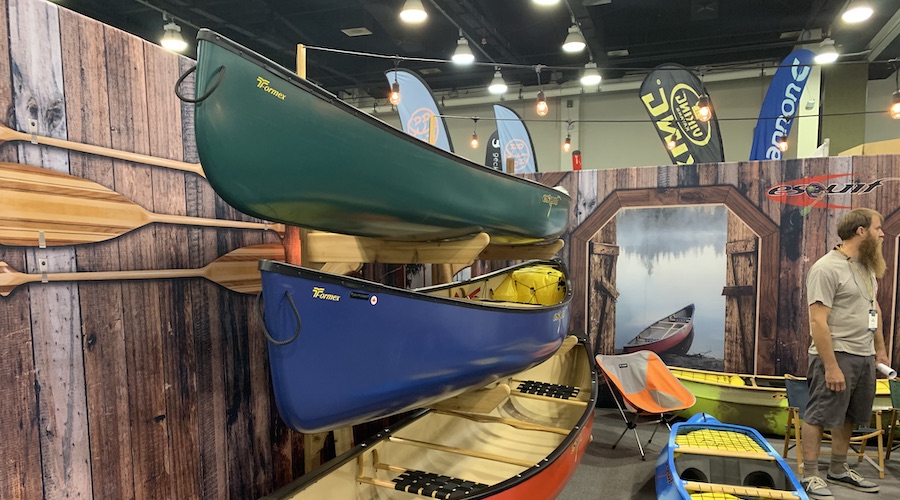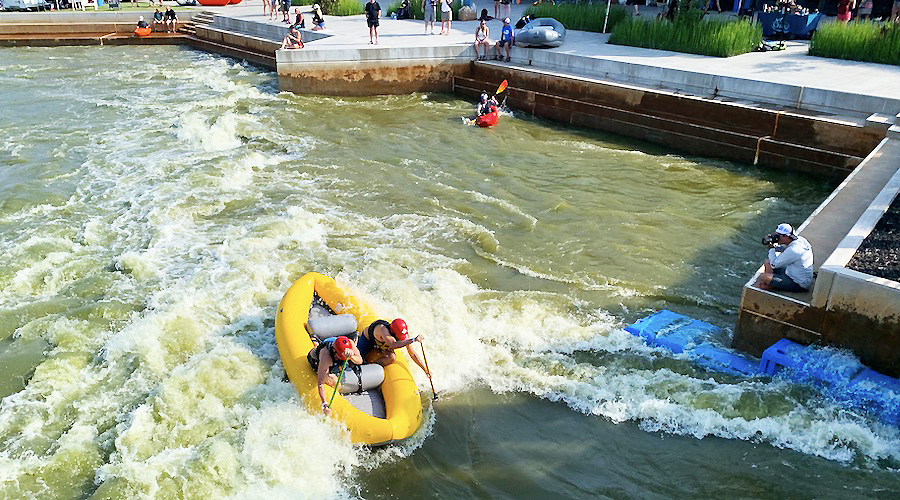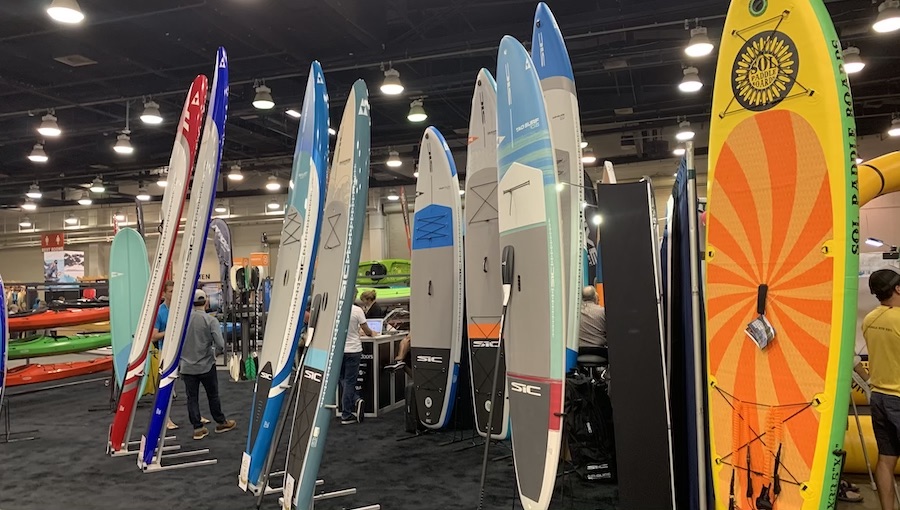By Eric Smith
<span style="color: #999999;">Despite industry-wide concerns over the impact of tariffs and a shifting trade show landscape, the vibe was rather chill at this week’s Paddlesports Retailer (PSR) in Oklahoma City.
Perhaps it was because the new demo format allowed flatwater and whitewater brands to hang out together at the same venue. Or maybe because the final day of the trade show ended early and allowed attendees to get home before the holiday weekend commenced.
Or maybe it was because momentum continues to build not only for the paddlesports industry but also for PSR—the “by paddlers, for paddlers” show that both unites and celebrates this tight-knit community.
No matter the reason, and it was likely a combination of them all, the third annual PSR provided plenty of goodwill for an industry that might have some challenges ahead but always faces them with a forward stroke.
And it provided plenty of fodder for this report, which is based on dozens of conversations with brands, buyers and other paddlesports industry stakeholders about some of the key business trends happening across their sports. Here’s what SGB saw and heard during our time in OKC.
1. The schedule gets tweaked, but is more change coming?
For a second straight year, Paddlesports Retailer was held in Oklahoma City during the week before Labor Day, but this year’s show had a couple of lineup changes that were mostly well-received.
The third day of the trade show, Thursday, August 29, was shortened to a half-day, enabling attendees to catch an afternoon or evening flight home.
Perhaps more importantly, both flatwater and whitewater brands had their demo day at RiverSport OKC whitewater park. For the first four hours, the park’s pumps were shut off to allow for calm water. Then they were turned on in the early evening for the whitewater portion of the demo day.
More tweaks could be coming, according to PSR’s Darren Bush, Charles Conner and Sutton Bacon, who told SGB the flatwater demo was a tad too long and might be shortened next year. But keeping all brands and buyers in one place and avoiding the annoying winds that wreaked havoc last year on the nearby Oklahoma River was a win-win for the event.
Click here to read a Q&A with Bush and Conner that SGB published prior to the show.
The demo went until 9 p.m., ending just before a massive thunderstorm pounded Oklahoma City. Thankfully, it didn’t hit until most show attendees were at dinner with their colleagues. More than a few people shared stories of power going out in the middle of their meals. Thankfully, they all said, the bars were able to mix and pour drinks in the dark. Crisis averted.
2. ‘It’s mayhem … and it’s awesome’
The demo day—especially the second half when the pumps were turned on for whitewater—was again the star of PSR.
The two loops of RiverSport OKC allowed dealers to take all sorts of canoes, kayaks, SUPs, packables, inflatables, surfboards and anything else that floats through a variety of rapids.
 Todd King, vice president of marketing at Greenville, SC-based Confluence Outdoor, said the demo day was “critical because we’re introducing 14 models for next season. It’s all about the ‘new’ for us.” That meant being in front of dealers who specialize in whitewater, flatwater, fishing or some combination of them.
Todd King, vice president of marketing at Greenville, SC-based Confluence Outdoor, said the demo day was “critical because we’re introducing 14 models for next season. It’s all about the ‘new’ for us.” That meant being in front of dealers who specialize in whitewater, flatwater, fishing or some combination of them.
“There’s nothing like touching and feeling it,” he said. “These are highly technical products and it’s important to have a venue to do that.”
Mike Harvey, co-owner of Salida, CO-based Badfish along with Zack Hughes and Luke Hopkins, spoke with SGB about the rapid growth of river surfing and the importance of having a venue that can show a buyer what a board from Badfish—or any other brand—can do in these conditions.
“It’s an incredible community builder,” he said.
As Harvey and others noted, demo day can get pretty wild with so many vessels running the rapids together. Plenty of spills and crashes occurred, especially with many paddlers trying to surf rapids while others barreled straight into them. But based on everyone’s smiles, even the wipeouts were delightful.
“It’s mayhem,” Harvey said, “and it’s awesome.”
3. This is the right spot in the calendar
Amid the recent trade show shuffling—specifically, the cancelation of Interbike in September and Outdoor Retailer Winter Market in November (which was wrapped into January’s Snow Show), one of the hottest topics at PSR was the relevance and timing of the show.
The relevance is obvious, with only paddlesports specialty retailers walking the aisles in search of gear for their stores.
And though some attendees, especially dealers, would like the show a couple of weeks later in early to mid-September, this week has proven to be to one that works best for the most paddlesports brands and buyers.
It’s certainly better timing than Outdoor Retailer Summer Market in June, almost everyone concurred. Many brands who were at PSR didn’t exhibit at the most recent OR for a variety of reasons, but the most common one was that it just doesn’t work with the paddlesports buying cycle.
“When OR announced the move to June, the paddle industry couldn’t possibly take a show cycle that started in June,” said Jeff Turner, sales/design manager for Arcata-CA-based drysuit and PFD brand Kokatat. “Our dealers are just starting to receive their goods for the current season, the snow’s melting and the water’s coming up. We couldn’t ask them to think that far forward.”
Kokatat, like some of the other larger brands at PSR, does exhibit at OR, but the company takes a different approach to the shows and each one serves a specific purpose.
 “We saw all of our major dealers at OR,” Turner said. “I was able to use OR to preview for the REIs, the MECs and the big accounts. This show I see as our pivot to the specialty business. We’re here to see the specialty dealer.”
“We saw all of our major dealers at OR,” Turner said. “I was able to use OR to preview for the REIs, the MECs and the big accounts. This show I see as our pivot to the specialty business. We’re here to see the specialty dealer.”
Seeing specialty dealers is why Gold Hill, OR-based Sawyer Paddles and Oars exhibits only at PSR and not OR. With so many specialty buyers at this paddlesports-only event, deciding which show to attend was an easy choice, said Derek Young, the company’s Northwest U.S. territory manager.
“We focus our tradeshows on where we know our customer is going to be,” Young said. “We can reinforce who we are to those who know us and introduce others to our products.”
Badfish’s Harvey echoed that assessment. While there is some value to being in a hall with most of the outdoor industry and getting a ton of traffic through the booth, he said, PSR has the right traffic that’s ready and willing to place orders for next season.
“At OR, we might talk to more people, but it’s not people who are serious,” Harvey said. “Here, we’re doing business.”
4. The ideal venue for valuable feedback
PSR is a place for longtime and well-known paddling brands to showcase their latest offerings, but it also is a proving ground for new or lesser-known companies to make an introduction to the specialty channel.
Kristi Hunter, head of marketing for Sage Marine, a boat maker in Golden, CO, said the company was at the show to get more visibility for its semi-custom sport boats, which are primarily sold direct. She said the company was getting plenty of traction thanks to a high-profile spot near the front of the exhibit hall.
And Andrew Salamon, the owner of Langford Canoe in Ontario, Canada, whose booth was also upfront, told SGB the brand was “trying to break into the channel” with its handcrafted, Canadian-made canoes.
Chung-Shih Sun was at his first PSR. He is the co-founder of Gearlab, a Taiwanese-based company that makes performance “Greenland” style paddles, which have thinner blades than European paddles.
He didn’t travel to the U.S. for Outdoor Retailer because a pair of trans-Pacific trips in two months wasn’t feasible. Instead, he figured PSR would give him the chance to truly showcase his product line, including a wide range of price points and materials that would appeal to all manner of dealers at the show.
“We’re trying to bring the Greenland kayak and paddle to this market,” Chung-Shih said. “But this is still a niche market for the U.S.”
Jeramie Vaine, team manager for Surftech and NSP, said the brands used the show as a way to introduce a foil board and get critical feedback from buyers. So far, so good on that front. “We’ve been listening to customers and heard a lot of great things,” he said.
But even the more established brands in the specialty channel see the same opportunity at PSR. Kokatat wanted to introduce a limited-edition version of one of its rescue jackets, and the brand wanted that to happen at PSR, where buyers value such unique offerings.
“We could have launched that at OR but no one was there to see it, so we launched it here,” Turner said. “We can use this show to help us reach out to that smaller bricks-and-mortar, more specialty-focused accounts.”
5. Inflatable expansion
Inflatables seemed to be all the rage at this year’s PSR. Kayaks and packable rafts were quite common at the demo day and in the exhibit hall, but stand-up paddleboards were ubiquitous.
Plenty of factors are driving the growth in inflatable SUPs, according to many of the brands that SGB spoke with. One, the products continue to get stronger and bombproof, said Matt Jones, U.S. director of sales for Surftech and NSP.
“People don’t wrap their brains around durability when it comes to inflatables,” he said.
Two, the price is right, said Dustin Elbing, national sales manager for Rave Sports, which is known for its water trampolines that came onto the market in 1997. At the show, however, Rave was debuting a line of inflatable SUPs for the 2020 season. PSR was the ideal spot to showcase the new product, get feedback from prospective dealers and, of course, land some accounts.
The rise of inflatables might seem like it’s being driven by the need for something to take up less space, Elbing said, but price point is boosting the category—especially when considering shipping costs.
“What’s driving the buying decision is the pricing,” he said.
Look for more shakeup in the SUP category, not just inflatables, according to Kristin Thomas, executive director of the Dana Point, CA-based Stand Up Paddle Industry Association (SUPIA), which represents stand-up paddleboard manufacturers, retailers, sales reps and distributors around the globe.
This was the organization’s first time exhibiting at PSR, and her booth was busy with SUP makers and curiosity seekers looking to learn more about the industry and how they can grow their own business, which has plateaued of late but remains strong.
“We had our period of exponential growth, but we are going through that period of reconfiguration,” she said. “The industry is growing, but it just isn’t growing as fast.”
6. Community building
Even as tariff news continued to swirl (most said they were adjusting their retail prices or adding a line item that some call a “Trump tax”) and trade show operators rightsize their schedules, the mood at PSR was buoyant.
Most boat and accessory brands lauded the event for the business they were generating from new and existing accounts—the primary reason they were attending.
“Every year at the show we’ve had a significant increase in dealer visits and sales growth,” said Chris Hipgrave, sales director, Pyranha Kayaks. “The industry needs to get together, so I see a bright future for it.”
Moreover, the show was about coming together as a paddlesports community, according to Sweet Protection North America’s Casey Garrity, marketing, and Mike Erwin, sales manager.
For example, the brand didn’t demo its products at the RiverSport OKC park—although Sweet Protection was highly visible during the demo, Garrity noted—but just having a booth and talking to dealers made the trip to Oklahoma from Colorado more than worthwhile.
“It’s being part of the family,” Erwin said.
That family extends far and wide, all the way up in Interior Alaska, where Josh Davis and his son, Nairn, operate CanoeAlaska, a kayak, canoe and SUP rental shop on the Chena River in Fairbanks, AK.
This was their first time to PSR and as they walked the show floor talking to vendors about potential rental gear for their outfit, they were still smiling from the day before, the adrenaline still flowing from running the rapids and trying out gear and getting to know their fellow tribe mates.
“It was the best day ever,” Josh Davis said.
Photos courtesy SGB Media
[author] [author_image timthumb=’on’]https://s.gravatar.com/avatar/dec6c8d990a5a173d9ae43e334e44145?s=80[/author_image] [author_info]Eric Smith is Senior Business Editor at SGB Media. Reach him at eric@sgbonline.com or 303-578-7008. Follow on Twitter or connect on LinkedIn.[/author_info] [/author]

















